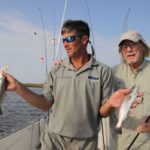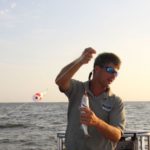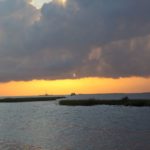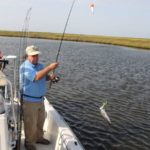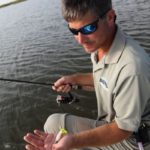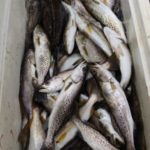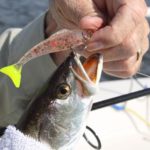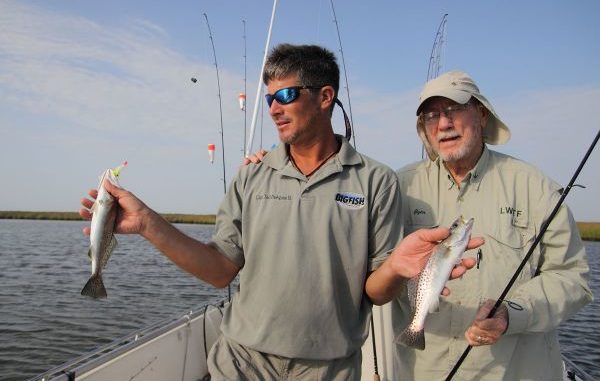
Popping corks are nothing new to coastal anglers, but this Delacroix captain has some thoughts on the best ways to fish them.
Momma didn’t raise no fool: I’ve always been a quick study. And Hopedale/Delacroix fishing guide Capt. Ted DeAgano has always been a teacher.
With a combination like that there was no doubt we were going to catch speckled trout in Bay Eloi — if the weather held.
Summer days can often be unpredictable, with isolated thundershowers creating instantaneous high winds and rough seas in a matter of seconds.
As fate would have it, such was the case on a late-summer trip a couple of outdoor media types and I made with DeAgano last summer. We’d planned to fish a little rig out in the bay where he assured us he’d been catching some nice trout.
But, it’s one thing to catch fish and another if the water is so choppy it’s at the point where it ruptures the L-4 or L-5 discs in your back while reeling in trout.
And though we picked up a few trout off the rig, DeAgano made the decision to move us to the calmer protected waters in Lake Anastasia.
Good thing because my bottle of anti-inflammatory meds was getting low, but it just showed me how much information our 40-year-old guide who had been fishing since he was 2 years old had stuck in his head.
DeAgano possesses that ability to make spur-of-the-moment decisions from years of experience that can make or break a trip.
“Whenever you’ve got 20-mph winds on the outside where the conditions are unbearable, you can try it — but sometimes it’s best to make the call and move early,” DeAgano said. “In our case, we might find the trout smaller in the lake, but there are plenty of them. And that old saying, ‘You give a man a fish and he’ll eat for a day — you teach a man to fish he’ll eat for life,’ that’s what I believe.
“When I’m on my boat and whether someone knows how to catch fish or not, I teach them how and where I fish. Usually their catch improves.”
One of the things that DeAgano pointed out about the lake was we happened to be fishing six days after a full moon. According to our captain, that meant the males were coming in to fertilize and protect the beds and the so called “big girls” were back on the outside where we had just come from.
Since we’d be catching smaller males, our guide also pointed out the motto he lived by.
“The smaller trout taste better,” he said.
DeAgano went on to explain why we’d catch these aggressive male trout.
“Fish on the beds are biting because they are burning calories protecting and fertilizing the beds, so they need carbs,” he explained. “When you put a bait in front of their face, they’re attacking.”
Lake Anatasia turned out to be much more pleasant, with barely a light chop on the water. And no sooner had DeAgano stabbed his stainless steel Cajun anchor than we were chunking popping corks into the shallow lake waters.
No doubt the use of a popping cork is a Gulf coast standard. But, DeAgano went into educating us on his poptological differences that help anglers improve their catch rates whether using live bait, which he prefers, or plastics.
“I use a 3-inch H&H popper on about a 32-inch leader using 30-pound Berkley Trilene and No. 4 split shot,” DeAgano said. “I’ll also add two No. 3 beads and a 1/0 Kahle hook. The cork only moves a couple of inches when I pop it. Other corks like concave or lemon-shaped corks will often move 2 feet. That places the bait 2 feet farther than where the bait’s original position was.
“Those fish are swimming around looking for where that bait is. You know where McDonalds is in town, and you always head to that one spot. When trout hear that pop they know right where to go.”
DeAgano said a lot of guys don’t use the cork he does because they cost more. But the guide insisted the H&H versions have better presentation in the water.
“It’s all about the pop,” he said. “With this particular cork and setup, the reaction time is better. And your pop is absolutely critical.
“Anytime I’m popping-cork fishing using artificial plastics, I like to give it a three- to five-second set in between pops. And when I’m fishing live bait like shrimp, I’ll give it any where from a 10- to 30-second set.”
Besides shrimp, which DeAgano fondly refers to as “white and brown sea crickets,” we also used Berkley Gulp! shrimp. Both the live and artificial bait seemed to perform equally well in Lake Anastasia.
However, variety is the spice of life, so we also used Berkley Mantis Shrimp and Egret Bait’s 3.5-inch Wedgetails in Cajun pepper color.
DeAgano described the Mantis as a mixture of the Gulp! Shrimp and Berkley Ghost, saying it was as soft as a Ghost and combined the tail of a Ghost and the body of a Gulp! shrimp.
The artificial baits were effective, and held together while we built up an ice chest full of scrappy male trout.
It being the hottest part of summer, the shallow water’s temperature was somewhere around 84 to 85 degrees, keeping most of the fish down low. Anchored in roughly 2 feet of water, DeAgano had us positioned to fish a channel.
“With the water in the mid-80s, it keeps the fish down low in the channel, where the water depth is about 5 feet deep,” he said. “We’re fishing right on top of their heads, so they’re coming up to strike. With our leaders set at 32-inches, we’re fishing about 1½ to 2-feet off the bottom.
“Trout like cooler water, and cooler water keeps shrimp alive. So what happens at this time of year is the hot water keeps them down low, and they come up to the bait striking it.”
DeAgano said when fish are down low, he will also fish the bottom using just a 1/0 Kahle hook with no jighead, letting it sit. When he picks it up and works the bait by twitching while reeling it in is when the fish hit it.
DeAgano fondly recalled how his father and uncle started a guide service called “Spots and Dots Charters” back in 1976. It was during the ’80s when the oil-field busted that their charter service went out of business.
But, that didn’t dissuade the young fisherman from starting his own fishing business.
“When I told them I was going to become a guide right out of high school they said no way your going to do it — you’ll lose everything,” said DeAgano. “Well I’m here. My days often start out around 3 in the morning and end around 9 at night. It’s a dark-to-dark business, and you have to be able to go-go-go.
“But, it’s not all about fishing and the numbers you catch. It’s about teaching other people to fish, too.”
On DeAgano’s business card it reads “Peace — Harmony — Abundance.” The nice part about our trip with the guide from Delacroix’s Lake Anastasia is it was all three.
